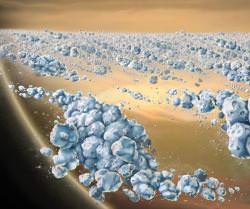Although the Solar System is 4.5 billion years old, planetary scientists thought that Saturn’s famous rings formed much later. Maybe as recently as a few hundred million years ago. But new observations from Cassini have pushed those estimate back… way back. Maybe all the way back to the beginning of the Solar System. Saturn’s rings might be ancient, with ring material getting recycled for eons.
According to Larry Esposito, principal investigator for Cassini’s Ultraviolet Imaging Spectrograph at the University of Colorado, Boulder, earlier data gathered by NASA’s Voyager spacecraft in the 1970s, and later from the Hubble Space Telescope indicated that the rings were young. Maybe a comet shattered one of Saturn’s moons about 100 million years ago, generating the particles we see today.
But the new evidence from Cassini shows the the rings vary in age significantly; the rings are being constantly replenished and recycled.
“The evidence is consistent with the picture that Saturn has had rings all through its history,” said Esposito. “We see extensive, rapid recycling of ring material, in which moons are continually shattered into ring particles, which then gather together and re-form moons.”
“We have discovered that the rings probably were not created just yesterday in cosmic time, and in this scenario, it is not just luck that we are seeing planetary rings now,” said Esposito. “They probably were always around but continually changing, and they will be around for many billions of years.”
So how can Cassini tell that there’s new material being generated. Astronomers used to think that infalling meteoric dust should pollute the older rings, making them darker. But the new Cassini observations show that the ring system spreads the pollution around, diluting it. This is why the rings appear to be so pristine and young.
They observed how the ring material blocked light from distant stars. They were able to detect 13 objects in Saturn’s F ring, varying in size from 27 metres to 10 kilometres (30 yards to 6 miles). Since most of the objects are translucent, the researchers think they’re just temporary clumps of icy boulders.
They appear to come and go, clinging together and then breaking apart under Saturn’s strong gravity. Although the rings always look the same, they’re being constantly recycled.
Original Source: NASA/JPL News Release


“They appear to come and go, clinging together and then breaking apart under Saturn’s strong gravity. Although the rings always look the same, they’re being constantly recycled”.
This last paragraph in the above article begs a question about earth’s gravity – that is:- are we lighter in the daytime and heavier at night?
Absolutely amazing! Another perspective is challenging our once-rigid understanding of science in space. Thank you for another intriguing article.
Just as with Josh M, it shows that true scientific understanding is a fluid concept, changing & evolving, not just a set, rigid immutable rule book.